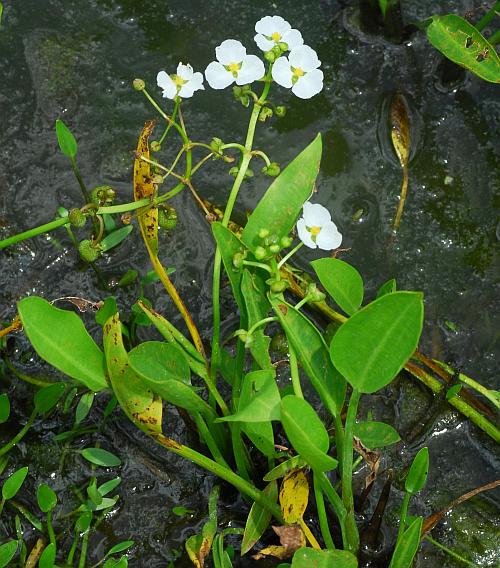Sagittaria platyphylla (Engelm.) J.G. Sm.
Arrowhead

Native
CC = 7
CW = -5
MOC = 8
SRank = S1
© SRTurner
Sagittaria platyphylla (Engelm.) J.G. Sm.Arrowhead | |
 |
Native CC = 7 CW = -5 MOC = 8 SRank = S1 |
© SRTurner |
|
Family - Alismataceae Habit - Perennial emergent aquatic forb, monoecious, with rhizomes and corms. Stems - Not present.
Leaves - Basal, simple, long-petiolate, 20-45 cm long, the petioles rounded to somewhat flattened or trigonal in cross section, the blades lanceolate to ovate, entire, glabrous. Submerged leaves uncommonly produced, linear.
Inflorescences - Unbranched racemes with whorled flowers, ascending to erect. Bracts at nodes of the inflorescence 3-7 mm long, fused in the basal half, the free portions triangular, obtuse. Lower 1-4 whorls of flowers pistillate, with reflexed, thickened pedicels 14-30 mm long.
Flowers - Actinomorphic, unisexual. Sepals 3, green. Petals 3, white, dropping soon after flowers open. Stamens and pistils numerous. Pistils separate, in a dense, headlike cluster on an expanded receptacle. Style 1 per pistil, the stigma decurrent. Ovaries superior, with 1 ovule.
Fruits - Fruiting pedicels stout, usually reflexed. Achenes obovate, 1.4-2.0 mm long, the beak 0.3-0.6 mm long, slender, curved.
Flowering - May - August. Habitat - Mud flats, sloughs, wet ditches. Origin - Native to the U.S. Lookalikes - Other members of the genus, especially S. graminea. Other info. - This is one of the rarer species of arrowhead in Missouri, where it is mostly restricted to a few counties in the Bootheel region. Its scarcity in the state makes it a species of conservation concern, with a state ranking of S1 (critically imperiled). The bulk of its U.S. distribution is within four states: Arkansas, Louisiana, Texas, and Oklahoma, with additional small disjunct populations elsewhere in the Southeast. Photographs taken just east of Otter Slough Conservation Area, Stoddard County, MO, 7-31-2015 and 6-26-2019 (SRTurner). |